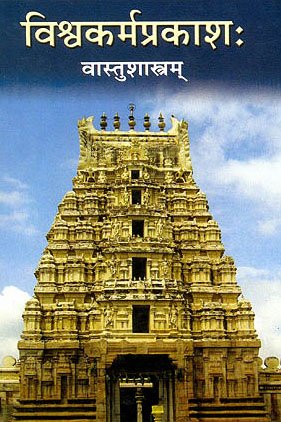Mulasthana, Mūlasthāna, Mula-sthana: 10 definitions
Introduction:
Mulasthana means something in Hinduism, Sanskrit, the history of ancient India. If you want to know the exact meaning, history, etymology or English translation of this term then check out the descriptions on this page. Add your comment or reference to a book if you want to contribute to this summary article.
Images (photo gallery)
In Hinduism
Vastushastra (architecture)
Source: Shodhganga: The significance of the mūla-beras (vastu)Mūlasthāna (मूलस्थान) or Garbhagṛha sanctum-sanctorum of the Hindu Temple.—Each temple has a garbhagṛha or mūlasthāna (sanctum-sanctorum) and many subsidiary sanctums. The temples here selected for the study of the mūla beras are temples specially dedicated to Śiva, Viṣṇu, Subrahmaṇya, and Pārvatī. In these garbhagṛhas, there are icons of gods and goddesses, namely, Śiva and His manifestations like Naṭarāja; Pārvatī and the Śakti avatāras; Viṣṇu and His other forms and incarnations; Brahmā, Lakṣmī, Sarasvatī, Subrahmaṇya, Valli, Deivāṇai (also known as Deviyāni or Devasena), and Gaṇapati.

Vastushastra (वास्तुशास्त्र, vāstuśāstra) refers to the ancient Indian science (shastra) of architecture (vastu), dealing with topics such architecture, sculpture, town-building, fort building and various other constructions. Vastu also deals with the philosophy of the architectural relation with the cosmic universe.
India history and geography
Source: Cologne Digital Sanskrit Dictionaries: Indian Epigraphical GlossaryMūla-sthāna.—cf. Tamil mūla-ttānam (SII 3; SITI; CITD), a place; the origin, base or foundation; the supreme spirit; the central shrine in a temple (SII 13); the place where the main image stands. (EI 18), an important seat of monks. Note: mūla-sthāna is defined in the “Indian epigraphical glossary” as it can be found on ancient inscriptions commonly written in Sanskrit, Prakrit or Dravidian languages.
Source: Heidelberg: Glory of the Tiruvanantapuram Padmanabhasvami TempleMūlasthāna (मूलस्थान) refers to the “original place” of a particular temple, or sacred spot.

The history of India traces the identification of countries, villages, towns and other regions of India, as well as mythology, zoology, royal dynasties, rulers, tribes, local festivities and traditions and regional languages. Ancient India enjoyed religious freedom and encourages the path of Dharma, a concept common to Buddhism, Hinduism, and Jainism.
Languages of India and abroad
Sanskrit dictionary
Source: DDSA: The practical Sanskrit-English dictionaryMūlasthāna (मूलस्थान).—
1) base, foundation.
2) the Supreme Spirit.
3) wind, air.
4) Mooltan.
-nī Name of Gaurī.
Derivable forms: mūlasthānam (मूलस्थानम्).
Mūlasthāna is a Sanskrit compound consisting of the terms mūla and sthāna (स्थान).
Source: Cologne Digital Sanskrit Dictionaries: Shabda-Sagara Sanskrit-English DictionaryMūlasthāna (मूलस्थान).—n.
(-naṃ) 1. Ether, heaven, space or atmosphere. 2. God. 3. Base, foundation. f. (-nī) Gauri. E. mūla primary origin, &c., and sthāna place, abode.
Source: Cologne Digital Sanskrit Dictionaries: Monier-Williams Sanskrit-English Dictionary1) Mūlasthāna (मूलस्थान):—[=mūla-sthāna] [from mūla > mūl] n. foundation, base, [Catalogue(s)]
2) [v.s. ...] principal place, [Varāha-mihira’s Bṛhat-saṃhitā [Scholiast or Commentator]]
3) [v.s. ...] the air, atmosphere, [cf. Lexicographers, esp. such as amarasiṃha, halāyudha, hemacandra, etc.]
4) [v.s. ...] a god, [cf. Lexicographers, esp. such as amarasiṃha, halāyudha, hemacandra, etc.]
5) [v.s. ...] Mooltan, [Catalogue(s)] etc.
Source: Cologne Digital Sanskrit Dictionaries: Yates Sanskrit-English DictionaryMūlasthāna (मूलस्थान):—[mūla-sthāna] (naṃ) 1. n. Ether, atmosphere; God. f. (nī) Gaurī.
[Sanskrit to German]
Sanskrit, also spelled संस्कृतम् (saṃskṛtam), is an ancient language of India commonly seen as the grandmother of the Indo-European language family (even English!). Closely allied with Prakrit and Pali, Sanskrit is more exhaustive in both grammar and terms and has the most extensive collection of literature in the world, greatly surpassing its sister-languages Greek and Latin.
Kannada-English dictionary
Source: Alar: Kannada-English corpusMūlasthāna (ಮೂಲಸ್ಥಾನ):—
1) [noun] the original inhabitancy of a human race, animal, etc.; the home.
2) [noun] the central, most important part of a temple, where the main idol is installed; the sanctum sanctorum.
3) [noun] a prominent or principal place.
4) [noun] one’s native village, town or place.
5) [noun] that part of a building, most part of which is under the surface of the ground, and on which the superstructure is constructed; foundation.
6) [noun] the Supreme Being.
7) [noun] the air or atmosphere.
Kannada is a Dravidian language (as opposed to the Indo-European language family) mainly spoken in the southwestern region of India.
See also (Relevant definitions)
Partial matches: Sthana, Mula.
Starts with: Mulastanam, Mulasthanatirtha.
Ends with: Jihvamulasthana.
Full-text: Mulasthanatirtha, Mulanivasa, Mulasthani, Punaravarta, Moolsthaan, Garbhagriha, Putluru, Vitankapura, Mulattanam, Anavarta, Avarta, Gejjihalli, Ulagalantha Perumal.
Relevant text
Search found 11 books and stories containing Mulasthana, Mula-sthana, Mūla-sthāna, Mūlasthāna; (plurals include: Mulasthanas, sthanas, sthānas, Mūlasthānas). You can also click to the full overview containing English textual excerpts. Below are direct links for the most relevant articles:
The Skanda Purana (by G. V. Tagare)
Chapter 197 - The Greatness of Mūlasthāna Tīrtha < [Section 3 - Revā-khaṇḍa]
Chapter 76 - Installation of Muṇḍīra, Kālapriya and Mūlasthāna < [Section 1 - Tīrtha-māhātmya]
Chapter 278 - Greatness of Mūlasthāna (Śūlasthāna) < [Section 1 - Prabhāsa-kṣetra-māhātmya]
Temples of Munnur (Historical Study) (by R. Muthuraman)
Siddhi Vinayaga shrine < [Chapter 4]
Kulottunga II (A.D.1133-1150 A.D.) < [Chapter 1]
Adavalleswarar or Adavalleeswarar Temple (Architecture) < [Chapter 4]
Later Chola Temples (by S. R. Balasubrahmanyam)
Temples in Chidambaram < [Chapter II - Temples of Kulottunga I’s Time]
Temples in Tiruvenkadu < [Chapter XIX - Supplement]
Appendix: Naralokavira’s Chidambaram Inscription < [Chapter II - Temples of Kulottunga I’s Time]
Early Chola Temples (by S. R. Balasubrahmanyam)
Temples in Velachcheri < [Chapter IV - Temples of Sundara Chola’s Time]
Middle Chola Temples (by S. R. Balasubrahmanyam)
Temples in Kolar < [Chapter IV - Temples of Rajendra I’s Time]
Temples in Ennayiram < [Chapter II - Temples of Rajaraja I’s Time]
Temples in Tiruchchengodu < [Parantaka I]
The Padma Purana (by N.A. Deshpande)
Chapter 78 - The pacification of the Sun (Bradhna, Sūra, Ravi, Āditya, etc.) < [Section 1 - Sṛṣṭi-khaṇḍa (section on creation)]
